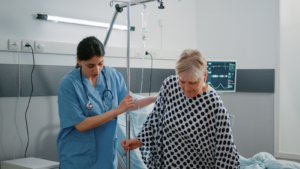Congress Newsletter 2022
Women are not being routinely informed that a common anaesthetic may make their contraception less effective, UK doctors warn
Abstract watch – 09AP05-11
- Drug may reduce the effectiveness of hormonal contraceptives, including the Pill and mini-pill
Women undergoing operations are not being routinely informed that a common anaesthetic may make their contraception less effective, putting them at risk of an unplanned pregnancy, new research being presented at this year’s Euroanaesthesia suggests.
The drug sugammadex is widely used in anaesthesia. Administered towards the end of the operation, ahead of waking the patient up, it reverses the action of drugs given earlier in the procedure to relax the patient’s muscles.
Sugammadex is known to interact with the hormone progesterone and so may reduce the effectiveness of hormonal contraceptives, including the progesterone-only pill (mini-pill), combined pill, vaginal rings, implants and intra-uterine devices.
Current guidance is to inform women of child-bearing age (WCBA) that they have received the drug and, due to increased risk of contraceptive failure, advise those taking oral hormonal contraceptives to follow the missed pill advice in the leaflet that comes with their contraceptives and advise those using other types of hormonal contraceptive to use an additional non-hormonal means of contraception for seven days.1
However, in the experience of the authors, robust methods for identifying at-risk patients and informing them of the associated risk of contraceptive failures is not common practice across anaesthetic departments within the UK, and are likely further afield.
To find out more, Dr Neha Passi, Dr Matt Oliver and colleagues at the Department of Anaesthesiology, University College London Hospitals NHS Foundation Trust, London, UK, surveyed anaesthetists at their hospital trust on their use of sugammadex and carried out a retrospective audit of sugammadex use in the Trust.
A seven-question survey was sent to all anaesthetists at the Trust. Including consultants, junior doctors and physician assistants, this numbered almost 150 professionals.
94% of the 82 anaesthetists who responded said they were aware of the risk of contraceptive failure. 70% of respondents said they do not routinely discuss sugammadex with the patients who have received the drug.
234 patients were administered sugammadex during the six weeks covered by the audit.
65 (28%) of the patients’ given sugammadex were WCBA and 48 of these should have received advice on the risks of contraceptive failure. There was no record of it, however, in the medical notes of any of the 48 women. (The other 17’s medical history meant they weren’t at risk of pregnancy and so not eligible for the advice.)
Dr Passi says: “It is concerning that we are so seldom informing patients of the risk of contraceptive failure following sugammadex use.
“Use of sugammadex is expected to rise as it becomes cheaper in the future and ensuring that women this receiving medicine are aware it may increase their risk of unwanted pregnancy must be a priority.”
Dr Oliver adds: “We only studied one hospital trust but we expect the results to be similar in elsewhere in the UK.”
Dr Passi adds: “It is important to note, however, that most patients receiving an anaesthetic do not need a muscle relaxant2 and that sugammadex is one of several drugs available to reverse muscle relaxation.”
In response to their findings, the study’s authors have created patient information leaflets and letters and programmed the Trust’s electronic patient record system to identify ‘at-risk’ patients and deliver electronic prompts to the anaesthetists caring for them in the perioperative period.
Sugammadex is the only anaesthetic drug known to have this effect.
References:
- www.ema.europa.eu/en/documents/product-information/bridion-epar-product-information_en.pdf
- https://www.nationalauditprojects.org.uk/NAP5report?newsid=1187#pt (chapter 19)
For full abstract click here
For full poster click here
Read More of our special newsletter covering our congress.










